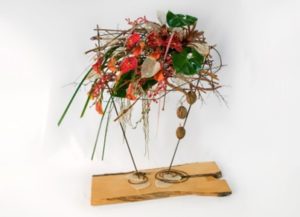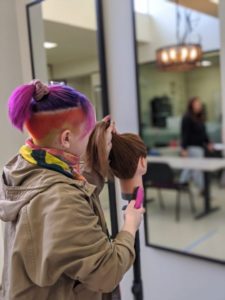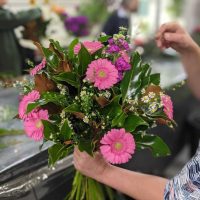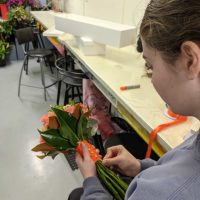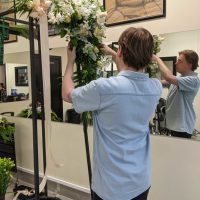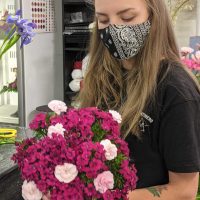QUALITY TRAINING IN VET
Lynne Kosky Memorial Lifetime Achievement Award Nomination
by James Milner & Sarah Bond
[/et_pb_text][et_pb_image _builder_version=”4.0.7″ src=”https://www.marjoriemilner.edu.au/wp-content/uploads/2020/01/mmc_fgs_2012-007-300×186-1.jpg” hover_enabled=”0″][/et_pb_image][et_pb_text _builder_version=”4.0.7″ hover_enabled=”0″]
WINNER OF THE 2012 MELBOURNE INTERNATIONAL FLOWER AND GARDEN SHOW THIS DISPLAY IS ONE OF GREG’S FAVOURITE.
Section A
Overview
It is difficult to write a short overview that will encompass a lifetime of outstanding achievements. I am nominating my father, whom I work with, for the Lynne Kosky Award as I believe he is by far one of the most outstanding VET teachers in Australia. His broad experience, ongoing passion and enthusiasm for his students and their future is very inspiring to me as I am a qualified teacher myself. I have interviewed my father in order to properly summarise his contribution to the VET sector. The questions asked and his answers are stated under the subsequent headings below.
Greg has been involved in vocational education since 1969. He is the current principal of Marjorie Milner College, which was founded by his late mother in 1946 (registered in 1995). The college is the largest provider of floristry apprenticeship training in the country. Greg is on the teaching floor four days a week as well as a Monday evening. Teaching is his passion and he values and respects all students with his main aim being to provide them with the best possible education to meet the industry’s needs. His students are actively involved in all industry competitions and their success reads like a ‘who’s who’ in floristry.
Greg was educated at Trinity Grammar School in Kew and he holds two educational degrees, including a Master in Education (University of Melbourne), five Diplomas and seven certificates. He is, without doubt, the most respected floristry teacher in Australia. His five educational floristry books span thirty-one years and have sold over four hundred thousand copies. Greg is currently a Worldskills judge (and was a judge in its predecessor, Workskills) and is the most senior Interflora National judge of thirty-nine years. In his training, he is presently recognised by Service Skills Australia as a Right Way Accredited Trainer and Assessor. He has made thirty-one educational training DVD’s which have been used in floristry teaching across the world. Greg was honoured and recognised by the Australian Florists’ Association in 1999, being inducted into the Floristry Hall of Fame.
Greg is a past Chairman of Interflora Victoria/Tasmania and he served voluntarily as the Educational Convenor for many years. Greg has taught and lectured, by invitation, in Japan, America, England, India and New Zealand. He has been presented to the Imperial Prince of Japan as a guest judge of floristry for Japan’s largest flower show. Greg was also honoured in 2006 to be invited to lecture in India on the benefits of competency-based training to eight hundred school principals.
Greg has worked for RMIT to broaden his educational experience. He particularly chose to work with students who had different forms of learning disabilities so that he could broaden his teaching skills and best learn how to assist them. He has been employed by TAFE Tasmania, in addition to working with North Melbourne Institute of Technology (NMIT), teaching floristry in Tasmania. Greg is an expert on competency-based training, having moved away from lock-step training in 1998. He has written several papers regarding his experience and positon on workplace based training which are discussed further in this submission.
His greatest joy is the success of his students whose achievements are outstanding. His training success in Worldskills has led to International representation by students on several occasions. The college has four student representatives competing in the national finals this year alone. Nearly all industry competitions are won by his students who participate throughout the year.
Besides writing books, Greg has written for many industry magazines over the last thirty years including educational articles for the Australian Florist Industry Magazine over the last five. He has been recognised for this effort in various ways. In 2009 he was awarded the prestigious American Institute of Floral Designers Certified Floral Designers Certificate. He has also won numerous industry competitions across the years with his most recent win being at the Melbourne International Flower and Garden Show in 2015. Greg has given his time freely to the industry over the past forty years to judge state and national competitions as well as demonstrating and running hundreds of teaching workshops for the industry.
In summary, Greg has been teaching in the VET sector for forty-seven years and his passion is as strong as it ever was. He is considered the expert of the industry (ask any florist). His dedication to the highest level of training recommends him for success in this outstanding award.
[/et_pb_text][et_pb_image _builder_version=”4.0.7″ src=”https://www.marjoriemilner.edu.au/wp-content/uploads/2020/01/8140418-oasis_design_cup_2014-076-300×200-1.jpg” hover_enabled=”0″ admin_label=”Image”][/et_pb_image][et_pb_text _builder_version=”4.0.7″ hover_enabled=”0″]GREG MILNER WITH NATAHLIA BRANDT AFTER HER SILVER WIN AT THE 2014 WORLDSKILLS COMPETITION. NATAHLIA STUDIED HER CERTIFICATE III IN FLORISTRY AS A SCHOOL-BASED APPRENTICE AND THEN WENT ON TO STUDY THE CERTIFICATE IV IN FLORISTRY FOLLOWED BY THE DIPLOMA OF FLORISTRY. SHE IS NOW WORKING AS A FLORIST IN LONDON AND WILL FLY BACK AS A WORLDSKILLS AMBASSADOR FOR THE COMPETITIONS IN OCTOBER.
[/et_pb_text][et_pb_image _builder_version=”4.0.7″ src=”https://www.marjoriemilner.edu.au/wp-content/uploads/2020/01/Victoria-Premier-Flower-Show-2015-169×300-1.jpg” hover_enabled=”0″ admin_label=”Image”][/et_pb_image][et_pb_text _builder_version=”4.0.7″ hover_enabled=”0″]MYSELF (JAMES MILNER), DANIEL ANDREWS (VICTORIAN PREMIER) AND MY FATHER, GREG, AT THE 2015 MELBOURNE INTERNATIONAL FLOWER AND GARDEN SHOW IN FRONT OF GREG’S WINNING DISPLAY.
Section B
Criterion 1: History of service
It is necessary to this section to refer to the early background leading to the foundation of Greg’s huge experience base.
Early background
Gregory Milner was born in 1952 into a family with very successful retail experience in the fields of floristry and hairdressing. His mother, Marjorie Milner, was passionate with regards to education and she saw a need for good industry training in floristry. In response to this need, she commenced formal training in 1946. His parents were foundation members of Interflora, running one of the largest florist businesses in Australia as well as training florists in the industry. Greg’s mother was the Educational Convenor for Interflora. This meant that she ran many workshops to educate the industry over the two states of Victoria and Tasmania. Greg was involved with these, as a helper, from a young age and later, holding the same convenorship, he ran numerous training workshops for the industry across the country. This was always unpaid and done for the benefit of the industry.
This short background is vital as it highlights what has shaped Greg’s passion and future in the education of florists and hairdressing (his paternal grandmother ran six hairdressing salons and his parents always ran a salon). Greg first competed in floristry in 1966 at fourteen years of age whilst still at school and he first demonstrated at the same age. I view this as quite an achievement given I was not doing anything of the sort at that age!
[/et_pb_text][et_pb_image _builder_version=”4.0.7″ src=”https://www.marjoriemilner.edu.au/wp-content/uploads/2020/01/First-Florist-Shop-Bourke-Street-Melbourne-254×300-1.png” hover_enabled=”0″ admin_label=”Image”][/et_pb_image][et_pb_text _builder_version=”4.0.7″ hover_enabled=”0″]GREG’S FIRST FLORIST SHOP AT 112 BOURKE STREET MELBOURNE. THIS PHOTO SHOWS HALF OF THE SHOP WHICH HAD SEVEN STAFF.
Greg entered the family business in 1969. He toured the world for five months, observing different floristry methods and on his return opened a florist shop in Bourke Street Melbourne (aged seventeen). He wore two hats, one being the family business of floristry which he worked in during the day and the second hat being a student teacher of floristry training the industry. This was of an evening (three nights per week) at the school founded by his mother. By 1971 Greg was taking classes as the sole teacher and he has taught continuously since 1969. All the records of every student and class is recorded at the college (the change from school to college took place in 2000).
Greg was involved in the early registration of Private Providers. The family school was recognised with great respect by the floral industry but not registered by the government. Marjorie Milner School of Floristry was registered in 1995 and from 1997 Greg was able to train apprentices. This is his passion above all other aspects of VET training. The success of his apprentices is absolutely outstanding.
Teacher Training
Greg was teaching at Marjorie Milner School of Floristry when the apprenticeship for floristry was proclaimed in 1976 (he and his mother were involved in this process). Teachers were to be formally trained through the Education Department. Greg loved fusing his industry background and knowledge into training and wanted to learn to be better at his craft. Box Hill TAFE (as it was called at the time) was selected for the training venue of the new floristry apprentices and given Greg was the only floristry teacher training the industry at that time he approached Gordon Bail, principal of The State College of Victoria, at Hawthorn to undertake teacher training. He was accepted and interestingly, he was the only student not employed by the Education Department. He also trained alongside three prospective teachers for Box Hill. Greg obtained a Trained Trade Instructor’s Certificate (1979) followed by a Diploma of Technical Teaching (1983).
Being married with a young family, running three shops, teaching night classes and attending the early markets to buy flowers, this was a very busy time of Greg’s life. Despite this, he continued to study and obtained a Degree in Education Technical (1986) and later he returned again to study a Master Degree in Education at Melbourne University (2002). Remarkably, the first floristry head of department for Box Hill TAFE was requested to attend Marjorie Milner School of Floristry to be taught by Greg and the tuition was paid for by the State Government.
Greg also holds a Certificate IV in Training and Assessment as well as and a Diploma in Training and Assessment.
Industry Judging, Lecturing and Teaching
[/et_pb_text][et_pb_image _builder_version=”4.0.7″ src=”https://www.marjoriemilner.edu.au/wp-content/uploads/2020/01/Diploma-of-Technical-Teaching-1983-198×300-1.png” hover_enabled=”0″ admin_label=”Image”][/et_pb_image][et_pb_text _builder_version=”4.0.7″ hover_enabled=”0″]GREG AFTER FINISHING HIS DIPLOMA OF TECHNICAL TEACHING IN 1983
In 1977, the first Interflora judges examination was held in Canberra by the floristry industry. The examination spanned three days and thirteen florists from across Australia sat through the process. Greg was twenty-five at the time and passed amply, obtaining the highest marks of all entrants. Five of the thirteen passed the examination. Greg has since been on subsequent judging boards examining industry experts for this qualification. Judging in the floristry industry was an extension of training. Often the industry workshops were associated with competitions and Greg often demonstrated to industry, organised workshops and taught for industry associations. This was always done voluntarily for the betterment of the industry. In 1978 Greg was first invited to judge the state heats of floristry for Workskills (the forerunner of Worldskills) which took place at Box Hill TAFE. Greg has since judged and demonstrated many times for World Skills and its predecessor Workskills. His most recent judging for Worldskills was last year.
Greg was asked by Teleflora (the largest relay company in the World at that time) to judge their first National competition in 1978 and he has judged state and National finals continuously from 1977 to the current day all over the country. If the past forty odd years were to be examined, there would be a consistent pattern of travel around the country to present a demonstration, judge a competition, give a verbal commentary and the following day teach the florists new and emerging techniques and then return home. Airfares and accommodation were paid for but time and expertise was given to the industry at no charge, up until more recent times.
Greg has been a chief examiner for subsequent industry judge’s qualifications. He has been invited to judge internationally which, as was mentioned earlier, usually involved teaching. Greg taught floristry in Japan each September from 1996 to 2005 moving from one city to another. This teaching took place when term break was in place in Melbourne. In 2001 Greg was presented to the Imperial Prince and Princess of Japan as he was a guest International judge at the Nagoya Dome Flower Show. As part of this event, numerous teaching sessions were organised across Japan training floristry employers and staff and on one occasion an excerpt from one of the demonstrations was shown on TV. Also in 2001, Greg was invited to demonstrate, lecture and teach in San Francisco, California, U.S.A, at the Palace of the Legion of Honor, the Fine Arts Museum of San Francisco.
[/et_pb_text][et_pb_image _builder_version=”4.0.7″ src=”https://www.marjoriemilner.edu.au/wp-content/uploads/2020/01/Imperial-Prince-of-Japan-300×213-1.png” hover_enabled=”0″ admin_label=”Image”][/et_pb_image][et_pb_text _builder_version=”4.0.7″ hover_enabled=”0″]THE IMPERIAL PRINCE OF JAPAN ADDRESSING THOSE WHO WERE PRESENTED TO THE PRINCE AND PRINCESS (SEATED BEHIND). THE JUDGES FROM THE SHOW WERE SEATED IN THE FRONT ROW AND WERE INDIVIDUALLY INTRODUCED TO, AND QUESTIONED BY, THE IMPERIAL COUPLE.
As was mentioned earlier, Greg was invited in 2006 to lecture to eight hundred college principals from across India on competency based training. The conference was opened by the Governor of Punjab, India and Greg was privileged to be the first guest speaker. As part of the trip he was invited to speak at a number of venues across India including at a number of press interviews.
[/et_pb_text][et_pb_image _builder_version=”4.0.7″ src=”https://www.marjoriemilner.edu.au/wp-content/uploads/2020/01/Inteflora-Demonstration-1979-239×300-1.png” hover_enabled=”0″ admin_label=”Image”][/et_pb_image][et_pb_text _builder_version=”4.0.7″ hover_enabled=”0″]Educational Publications
The experience of formal teacher training brought Greg a discipline of research and he started to formulate his teacher research into a solid training document. He approached Currey O’Neill Publishers and in 1984 “The Art of Flower Arrangement”, a complete guide to Floristry was published. Twenty-five thousand copies were printed for the first run and distributed across Australia, New Zealand and South Africa. A national campaign was launched with television interviews, demonstrations on live television and radio interviews in all states of Australia (over one hundred interviews to date). A three-page spread was featured in Woman’s Day. The book sold out in three months. Subsequent editions followed and a re-write was published in 1987. This was followed by another national advertising campaign across the country. During the 80’s Greg was also writing for the horticultural publication ‘GreenWorld’ as well as for the Interflora Unit News in both Australia and Great Britain and the Funeral Industry Magazine.
[/et_pb_text][et_pb_image _builder_version=”4.0.7″ src=”https://www.marjoriemilner.edu.au/wp-content/uploads/2020/01/Womens-Day-Spread-300×210-1.png” hover_enabled=”0″ admin_label=”Image”][/et_pb_image][et_pb_text _builder_version=”4.0.7″ hover_enabled=”0″]TWO PAGES OF THE THREE-PAGE SPREAD FEATURE FROM THE WOMEN’S DAY MAGAZINE WHICH HIGHLIGHTED SOME SECTIONS OF GREG’S FIRST BOOK PUBLISHED IN 1984.
In 1990 Greg produced and made seven floristry training videos. This media form was well ahead of its time and Greg used these resources in his own teaching as well as at educational industry workshops. This helped to balloon the distribution of the recorded demonstrations across the world. Greg continued making videos and then DVD’s when they came into mainstream production. Thirty-one educational DVD’s, each an hour in length were made by Greg. In 1993 two more books were published by Viking O’Neil (Penguin Books). These were titled “The Complete Book of Flower Arrangement” and “Wedding Flowers”. These both had a national and international distribution run and are both still highly sought after today.
In 2010 Greg launched another book titled “Fresh Cut Flowers”. This was written to assist students in floristry research as there was not enough relevant information available on the uses of flowers specific to floristry, their lifespan and the correct cool-room temperatures for different flower varieties. It is currently a recommended text in many training institutes involved with floristry.
Greg has always written the training and assessment guides for his students and he is very proud of these. He is currently finishing the guides and assessments for the new floristry training package released in 2015. Box Hill Institute, Gordon Institute and Challenger TAFE Western Australia have requested to purchase the guides Greg has created.
I asked Greg about his books and why he wrote them. His response was:
“If someone had asked me if I would ever write a book when I was at school I would have said, not possible. Teacher training opened this opportunity to me. I gained more confidence using my industry knowledge and guided by fantastic, dedicated teachers such as Ern Bastow, Ian Rankin, Blair Edgar and Gordon Bail (the principal). I was encouraged to write about my area of expertise. At teacher’s college they really asked you to do the maximum you could do and with their support I started writing to assist my students with more detailed information. My first book, published in 1984, greatly assisted so many students, not only mine, but all over the country, and employers called it their ‘Floristry Bible’. I continued writing and a new edition, with considerable rewrites and a new chapter, was published in 1988. As trends changed I continued writing. Two more books came out of this in 1993. Teacher training makes you analyse every step you teach and there were very few support materials available at the time. That is another reason why I wrote Fresh Cut Flowers (2009). This was a different book to assist learners with more relevant shop handling procedures with flowers. Again it is referred to as the florist’s bible. Looking at the experiences with the demonstration videos, and then DVD’s, I think these have also been great teaching aids that help stimulate different learning styles”.
[/et_pb_text][et_pb_image _builder_version=”4.0.7″ src=”https://www.marjoriemilner.edu.au/wp-content/uploads/2020/01/resources1-300×130-1.jpg” hover_enabled=”0″ admin_label=”Image”][/et_pb_image][et_pb_text _builder_version=”4.0.7″ hover_enabled=”0″]THE COVER OF GREG’S BOOK ‘FRESH CUT FLOWERS’ PUBLISHED IN 2010 WAS INTENDED TO ADDRESS INFORMATION FROM THE TRAINING PACKAGE THAT WAS DIFFICULT FOR STUDENTS TO RESEARCH.
Demonstrations
In 1990 the Department of Agriculture and Rural Affairs invited Greg to speak about floristry training. Greg had, on a previous occasion, been requested to present a paper on the ‘Post-Harvest Care of Cut Flowers’. Greg’s information, from the paper, was published by the department. Also in 1990 Greg was invited by the Royal Society of Western Australia Floral Art Society to demonstrate, judge and lecture at South Perth Town Hall. Greg has been requested to do the same by the Royal Australian Floral Art Society. Again in 1990, Greg was requested by Grandifora, Australia’s largest rose grower and importer, to present a demonstration of their new varieties of roses to the industry. Two hundred florists attended. Greg has demonstrated in all Myer state city stores across Australia. Furthermore, he has demonstrated for Apack, the largest sundry supplier in the country, at all the major industry events.
[/et_pb_text][et_pb_image _builder_version=”4.0.7″ src=”https://www.marjoriemilner.edu.au/wp-content/uploads/2020/01/Demonstrating-at-the-MIFGS-mainstage-300×204-1.png” hover_enabled=”0″ admin_label=”Image”][/et_pb_image][et_pb_text _builder_version=”4.0.7″ hover_enabled=”0″]GREG DEMONSTRATING ON THE MAINSTAGE AT THE MELBOURNE INTERNATIONAL FLOWER SHOW IN 2003 WITH KIYOKO HAGIWARA, FROM JAPAN.
Two years in a row, 1998 & 1999, Greg was asked by “The Friends of the Institute for Child Health Research” to demonstrate for charity in Western Australia with all proceeds going to the Child Health Research. This was at the ballroom of the Novotel Langley Plaza Hotel attended by two hundred and fifty guests.
Going back in time, Greg has been asked by Adult Education Tasmania to take classes from 1977. Many workshops continued across the years in Burnie, Launceston and Hobart. Greg was also invited to demonstrate and teach by the Association of Tasmanian Florists. Today, the college is the only trainer of floristry apprentices for Tasmania.
[/et_pb_text][et_pb_image _builder_version=”4.0.7″ src=”https://www.marjoriemilner.edu.au/wp-content/uploads/2020/01/mmc_fgs_2015-022-300×200-1.jpg” hover_enabled=”0″ admin_label=”Image”][/et_pb_image][et_pb_text _builder_version=”4.0.7″ hover_enabled=”0″]GREG’S WINNING ENTRY INTO THE 2015 MELBOURNE INTERNATIONAL FLOWER AND GARDEN SHOW.
Criterion 2: Significant contribution and positive influence on the VET sector
I refer to a paper in this section which was submitted by Andrea Bateman titled “Demonstrating quality” This research features an article where Greg and the college were a case study and it was published by the National Centre for Vocational Education Research (NCVER) 2006 on behalf of the Australian Government and the State and Territory governments. It is titled “Helping students flower” and sums up the methodology of the college and Greg’s leadership at that time. Excerpts of this report are pictured below.
[/et_pb_text][et_pb_image _builder_version=”4.0.7″ src=”https://www.marjoriemilner.edu.au/wp-content/uploads/2020/01/Helping-Student-Flower-NCVER-Marjorie-Milner-College-300×271-1.jpg” hover_enabled=”0″ admin_label=”Image”][/et_pb_image][et_pb_text _builder_version=”4.0.7″ hover_enabled=”0″]THE TITLE OF THE REPORT WHICH WAS DEVELOPED AS PART OF THE CONSORTIUM RESEARCH PROGRAM: ‘SUPPORTING VOCATIONAL EDUCATION AND TRAINING PROVIDERS IN BUILDING CAPABILITY FOR THE FUTURE’.
To further explain how my father has contributed significantly to the VET sector, in a positive way, I have asked him a series of questions so he can explain his methods, experiences and teaching methodology.
Question one: Are you proud of the achievements of the apprentices you have trained?
Immensely, I consider myself fortunate to have the opportunity to make a positive lifetime mark on an apprentice’s future. There is a great fusion between experiencing all facets of industry being a major decorator, wedding florist and experiencing all aspects of the industry blending all these experiences with teaching experience and sharing this with the students. I enjoy the challenge different learners present. Our apprentices, for twenty years, have won nearly all industry competitions. This is great for the high achievers and we are very proud of their achievements but it is the opportunity to help a student who is struggling or misdirected that is the most satisfying. Let me explain – I can think of many examples across the years of students who want to obtain a qualification but feel it may never happen as they doubt themselves. Many factors come into play.
I shall use two case studies, the first being a country female apprentice who worked in Geelong. I will not name her but she came into training with a very negative attitude. I know her employer and we liaised as we do with all our employers. I felt drugs were in play and her self- esteem was very low but we encouraged and supported her and in time her skills continued to grow. In the early stages the employer had had enough but I could see potential and asked for more perseverance. The employer did persevere and that student went on to win the Melbourne International Flower and Garden Show Advanced competition, the Interflora Florist of the Future and she won the national Worldskills competition and although she was just over the age limit for the international competition her marks were so high that Worldskills awarded her a scholarship to England to advance her floristry. I can honestly say our training and encouragement changed her life and its future course. I received a letter from her parents thanking us so much as they thought they had lost their daughter to drugs and how her life now was all positive. She is a very well respected florist today. Opportunities like this are why I teach. But you have to try so many different approaches and be the master of patience to succeed.
[/et_pb_text][et_pb_image _builder_version=”4.0.7″ src=”https://www.marjoriemilner.edu.au/wp-content/uploads/2020/01/Top-1st-Year-Apprentice-238×300-1.jpg” hover_enabled=”0″ admin_label=”Image”][/et_pb_image][et_pb_text _builder_version=”4.0.7″ hover_enabled=”0″]TOP 1ST YEAR HAIRDRESSING APPRENTICE OF THE YEAR AWARD WITH HAIRJAMM IN 2015.
[/et_pb_text][et_pb_image _builder_version=”4.0.7″ src=”https://www.marjoriemilner.edu.au/wp-content/uploads/2020/01/Victorian-Training-Awards-2009-206×300-1.png” hover_enabled=”0″ admin_label=”Image”][/et_pb_image][et_pb_text _builder_version=”4.0.7″ hover_enabled=”0″]THIS IS ONE OF THE MANY CERTIFICATES AWARDED TO MARJORIE MILNER COLLEGE.
The second example is quite recent and is about one of the most disruptive students you could possibly teach. In time, as confidences were won over, I found out this girl had been sexually abused as a child. She completed her apprenticeship (at times I had to convince her and her employer to keep going) and she said to me once she had finished “this is the first thing I have ever completed and I never thought I would”. I didn’t think she would finish at times either but we kept trying. Surely this is what good teaching is all about. There are many, many more stories to tell.
On a sidenote, I am equally proud of the success our hairdressing apprentices are enjoying in industry competitions as well as the top Hairdressing, Beauty Industry Association (HBIA) award for Beauty Therapy. Congratulations to our dedicated teachers.
Question two: Are you sorry you were unable to teach during the day prior to registration rather than taking night classes.
The answer is really yes and no. Running the largest wedding business in floristry and handling so many corporate accounts gave me a wealth of industry experience to pass onto my students. Being able to teach students about handling large accounts, like the one I held for a number of years with the Labour State Government to decorate Parliament House, and with other major corporations such as Mietta’s, Athenaeum Club, Head offices of Westpac, National and ANZ banks and numerous high profile firms, you could pass on many practical experiences that students might otherwise miss if only working in a small shop. Furthermore, when you can show your work on the front page of Vogue or tell them you made table centres for several dinners where the Prime Minister, Bob Hawke, was the guest you inspire confidence that you, as their teacher, have vast industry experience. I was able to pass my knowledge to employers and staff outside apprenticeship before registration but what I wanted most was to train apprentices. Having extensive industry experience allows a VET teacher to teach any industry aspect required. There are some teachers in the field who have not experienced vast corporate decorating work or large scale wedding work and this can limit their teaching skills. My experience of everything to do with these events is very well known and reinforces the respect of my position as an expert in the industry. I have been asked by a student “do you think so” and I usually respond with “I know so”. I do not regret the thirty odd years of night classes and in some years it was Saturday afternoon class as well. You know James, I could not run the businesses and teach during the day so when the decision was made to sell the shops so that I could teach apprentices each day, the timing was right. That was in 1999.
Question three: What are your thoughts on competency-based training?
I was trained as a lock-step teacher. In 1997, after twenty-eight years of lock step teaching, I moved to the challenge of competency based teaching. I found it very difficult in the first year as you are so used to explaining, and demonstrating, to a group. The skill was to clearly break the knowledge down to individual learners. With competency based learning, regarding students at different levels, the challenge was “have I missed telling them something or observing something” as there was so much information directed to each individual learner rather than a group of learners and about different levels of learning. This lead to the development of better learning guides. Having written books helped and having now developed over a period of time, I firmly believe our resources in floristry are by far the best in the country. To teach competency-based learning I feel one teacher can only adequately cover a class of over twelve as a maximum. If a student needs a demonstration or role play what happens to the rest of the class? Teacher management skills must be constantly improved. For a class of twenty we implemented two teachers per class. We trialled this back in 2003 and as you know I team teach. It works brilliantly in this method of training. My co-teacher in floristry studied with our college and now holds a Master of Adult Global Education and in 2012 she, Nicole Gibson, was awarded the VET teacher of the Year by ACPET. Our system benefits the students and no-one is held back as is the potential downfall of lock-step. In conclusion, I think that competency based, like any method, has faults but it is a better learning method than lock-step.
[/et_pb_text][et_pb_image _builder_version=”4.0.7″ src=”https://www.marjoriemilner.edu.au/wp-content/uploads/2020/01/RightWayProgram-210×300-1.jpg” hover_enabled=”0″ admin_label=”Image”][/et_pb_image][et_pb_text _builder_version=”4.0.7″ hover_enabled=”0″]GREG IS ONE OF THREE RIGHT-WAY APPROVED FLORISTRY TRAINERS IN AUSTRALIA. ANOTHER IS NICOLE GIBSON WHO ALSO WORKS AT MARJORIE MILNER COLLEGE.
Question four: What are your thoughts on work-place based training?
I decided to embrace work-place based training from 2004. My non- teaching day is Friday. My wife and I became the Milner travelling road show. We would do runs to florists such as Seymour to Benalla, to Wangaratta to Wodonga. This would be Friday and Saturday. We had apprentices in each town. The positives were seeing the apprentice in the workplace, talking with the employer and gaining more respect of our teaching and knowledge within the industry.
The downside was that all too often we could not be able to train in the required area. Often the shop was busy, sometimes short staffed and flowers ordered did not arrive or were needed for orders. I often ended up taking and making orders to help the business. We gained more apprentices across the state but you need to see the apprentice a minimum of monthly and keeping them on track with their work was difficult. The workplace based system only works well out-of-work hours for bench training so that time is not lost in constant interruptions. I speak specifically for the floristry industry. The facilities at the college are better equipped than many shops so we now offer alternatives to regional students in place of workplace based training. We still make visits to shops across Victoria and Tasmania on a regular basis and have visited many shops so far his year. It is great a great opportunity to liaise with employers. Our visits raise the perception of VET training by the industry as personal communication is always the best form of communication.
[/et_pb_text][et_pb_image _builder_version=”4.0.7″ src=”https://www.marjoriemilner.edu.au/wp-content/uploads/2020/01/AIFD-Greg-Milner-300×215-1.jpg” hover_enabled=”0″ admin_label=”Image”][/et_pb_image][et_pb_text _builder_version=”4.0.7″ hover_enabled=”0″]GREG HAS BEEN A CERTIFIED FLORAL DESIGNER WITH THE AIFD SINCE 2009. HE IS STILL CURRENTLY CERTIFIED WITH THEM.
Question five: After forty-seven years of training do you intend to retire soon?
My wife and I travel overseas each year. Last year we met with the President of Florint (the largest organization in floristry worldwide) to discuss floristry training. We have visited schools all over the world. I was invited to teach at the Constance Spry School of Floristry, England, in 2007. This school is famous across the world. We see what is going on internationally and whilst I feel I am on top of everything going on in the industry I will keep teaching. We meet well known designers in their shops and it continues to broaden our horizons. This is in turn passed to the students. Personal integrity is so important and exuding professionalism within your teaching skills at all times. I still feel I have so much to offer and I still feel the thrill of students achieving great success with their work and learning. If my passion wanes, then it is time to go.
Question six: How do you succeed with apprenticeship training?
The industry makes this choice. We need to ensure we are that choice. What you put back into the industry by way of standards either makes or breaks you. Our success is liaison with employers and quality training. As you know we ring if an apprentice is late or away. Employers learn to trust you. If an apprentice has a really positive day we let the employer know and often send a photo. If there are problems again it is a phone call. Communication is the key. I despise the concept of a ‘four day a week’ course. Would I employ that person? Most unlikely, as they must be able to produce quality work within a set timeframe. I take the view with all apprentices – “would I employ them? If not, why and how can I assist the learner to reach that objective?” Our method and view is identical in each department. If you are training for industry, you must talk with industry.
I am really excited about the new training packages that have just come out. Working through all sections of the package and checking compliance I have adapted our approach and I look forward to trialling the new formats. These guides and assessments are a work in progress. It is the same as writing several books but we are extremely proud of the guides’ quality and they are completely adaptable to part on-line learning.
[/et_pb_text][et_pb_gallery _builder_version=”4.0.7″ gallery_ids=”1164,1163″ show_pagination=”off” show_title_and_caption=”off” hover_enabled=”0″][/et_pb_gallery][et_pb_text _builder_version=”4.0.7″ hover_enabled=”0″]THE LEFT PHOTO SHOWS GREG BEING INDUCTED INTO THE FLORISTRY HALL OF FAME IN 1999. THE PHOTO ON THE RIGHT SHOWS GREG WITH ALAN RANDALL-SMITH AND BARBARA HAWKINS (WRAPS) WHO WAS INDUCTED INTO THE ALLIED AWARD OF HONOUR, ALSO IN 1999.
Criterion 3: Leadership
Greg served on the Interflora state (Victoria and Tasmania) committee for fifteen years. This was a voluntary position. During this time, he was Education convenor, Social convenor, Vice-chairman and Chairman from 1988 to 1990.
He has been involved with Service skills in many meetings and tele-conferences regarding floristry training. He also liaises regularly with Flowers Victoria. The president meets with Greg each year to discuss the Melbourne International Flower Show and its direction (Flowers Victoria part owns the show). Greg is the current president of the Australian Association of Floral Designers. This is a non-for-profit industry organisation. Greg is and has been involved with TAFE meetings regarding industry training. We meet a minimum of four times a year.
The college is looked upon as the industry leader rather than the other way around due to Greg’s vast experience and industry respect.
Greg is very involved in training packages and enjoys the respect of telephone calls to verify and comment on content. He has attended numerous meetings since training packages were introduced.
Greg firmly believes that the college has a valued reputation for quality practice within the Education Department. Again he has attended many meetings in relation to training within the department.
In 2016 Greg met with Kangan-Batman TAFE to discuss training issues. He also has meetings with Norman Grey, the CEO of Box Hill Institute.
In his capacity as President of The Australian Association of Floral Designers Greg organises and presents industry events across the year.
[/et_pb_text][et_pb_image _builder_version=”4.0.7″ src=”https://www.marjoriemilner.edu.au/wp-content/uploads/2020/01/AAFD-Melbourne-Function-MMCollege-300×171-1.jpg” hover_enabled=”0″ admin_label=”Image”][/et_pb_image][et_pb_text _builder_version=”4.0.7″ hover_enabled=”0″]As the most experienced and longest serving industry qualified judge Greg is still active in industry competitions and industry events. Interflora and The American Institute of Floral Designers require their judges to present industry currency before acting as a judge. As mentioned earlier his articles are read nationally and his books are treated as major industry resources. The Royal Horticultural Society of Great Britain, based at Kew Gardens, England, reviewed Fresh Cut Flowers, and gave Greg’s book a five-star rating.
Greg has attended many meetings regarding education in the VET sector including meetings with the late Lynne Kosky. On one occasion Lynne Kosky presented one of our national Worldskills winners at The Palladium Ballroom, Melbourne.
Through these wonderful opportunities we have made a difference to many lives, but the focus is not just the high achievers. You make a difference if a learner reaches their individual best and these levels will vary. The goal is the same.
Footnote:
Gregory Milner was fortunate to have grown up in a family environment of retail, business and education. In short his maternal great-grandparents were flower growers followed by his maternal grandfather who was a flower grower and his maternal grandmother was a teacher. They both ventured into retail floristry before the Second World War and then Greg’s parents ran one of the largest florist businesses in Australia. Greg’s mother was passionate about education and commenced training florists in 1946. His paternal grandmother was a very successful business woman who ran six hairdressing salons and barber shops. His father is a trained hairdresser / barber and florist and his sister is also a trained hairdresser and florist. His uncle and aunt ran florist businesses and currently he has cousins running florist stores and hairdressing salons / barber shop.
Marjorie Milner College trains in Floristry, Hairdressing, Beauty Therapy and Barbering. The floristry and hairdressing departments specialise in training apprentices. All hairdressing students are apprentices. The head of Beauty Therapy has one extra year of training up on Greg and Beverley would be another exceptional candidate for this award. We are very proud of our college, its facilities and the high standards we maintain. We are gratified at the opportunity to shape lives.
QUALITY TRAINING IN VET BY JAMES AND SARAH.
[/et_pb_text][et_pb_gallery _builder_version=”4.0.7″ gallery_ids=”1170,1169,1168,1167,1166″ show_pagination=”off” show_title_and_caption=”off” hover_enabled=”0″ posts_number=”6″][/et_pb_gallery][et_pb_text _builder_version=”4.0.7″ hover_enabled=”0″]The College today offers pathways Diploma of Beauty Therapy, Certificate II – IV in Floristry and Diploma of Floristry Design, Certificate III in Hairdressing (Apprenticeship), and Certificate III in Barbering (Apprenticeship)
[/et_pb_text][/et_pb_column][et_pb_column type=”1_3″ _builder_version=”4.0.7″][et_pb_sidebar area=”sidebar-1″ _builder_version=”4.0.7″ global_module=”1039″ saved_tabs=”all”][/et_pb_sidebar][/et_pb_column][/et_pb_row][/et_pb_section]
